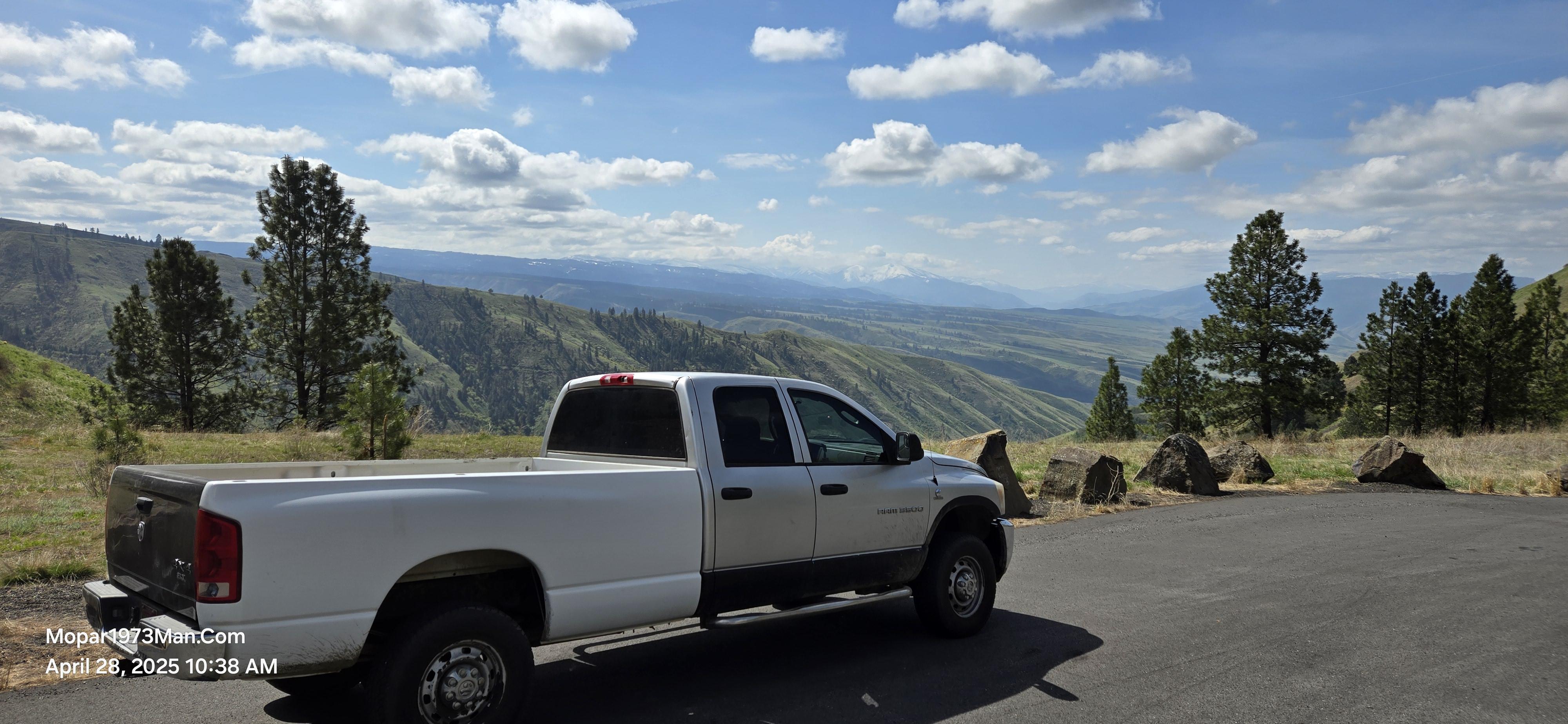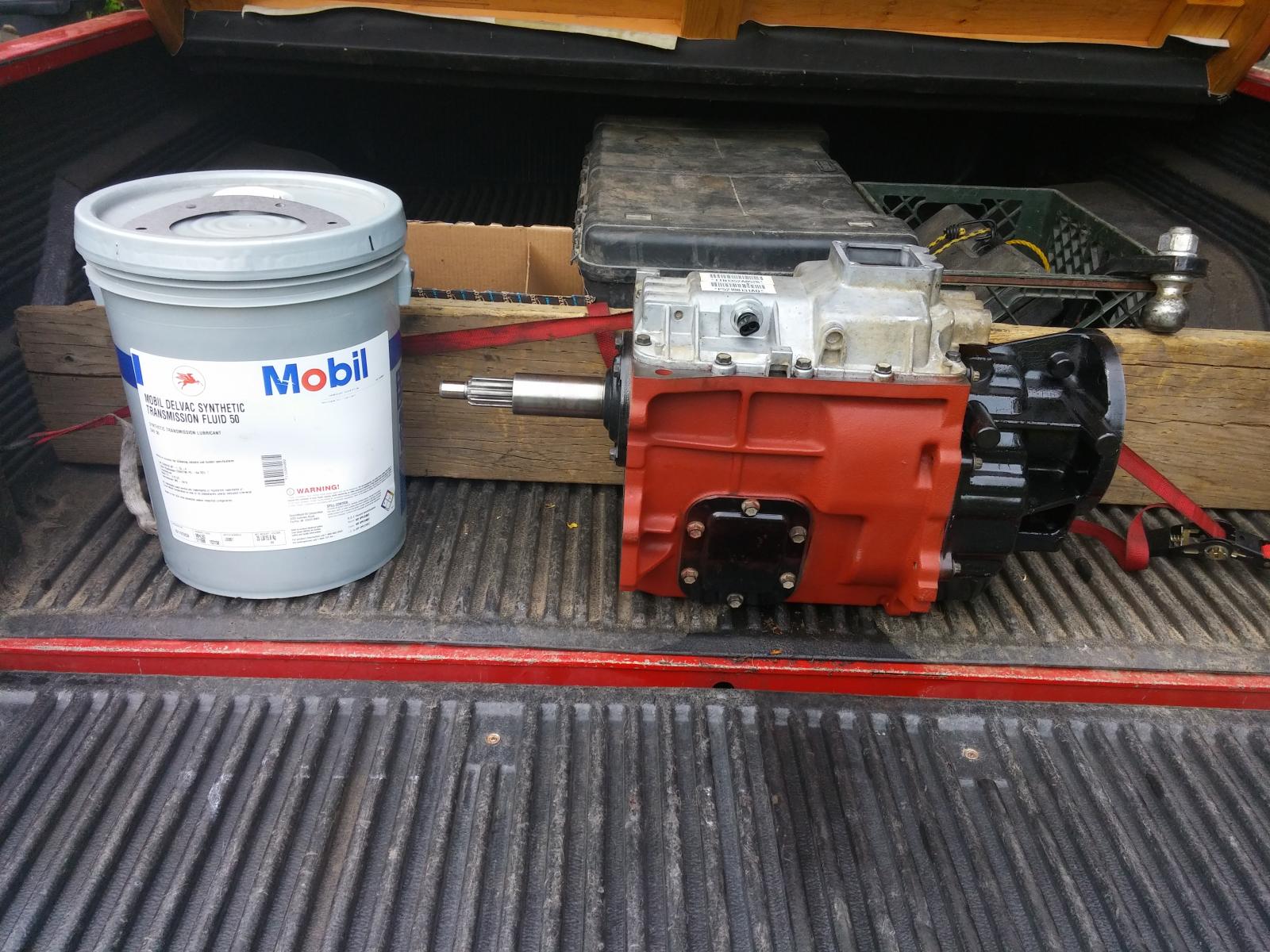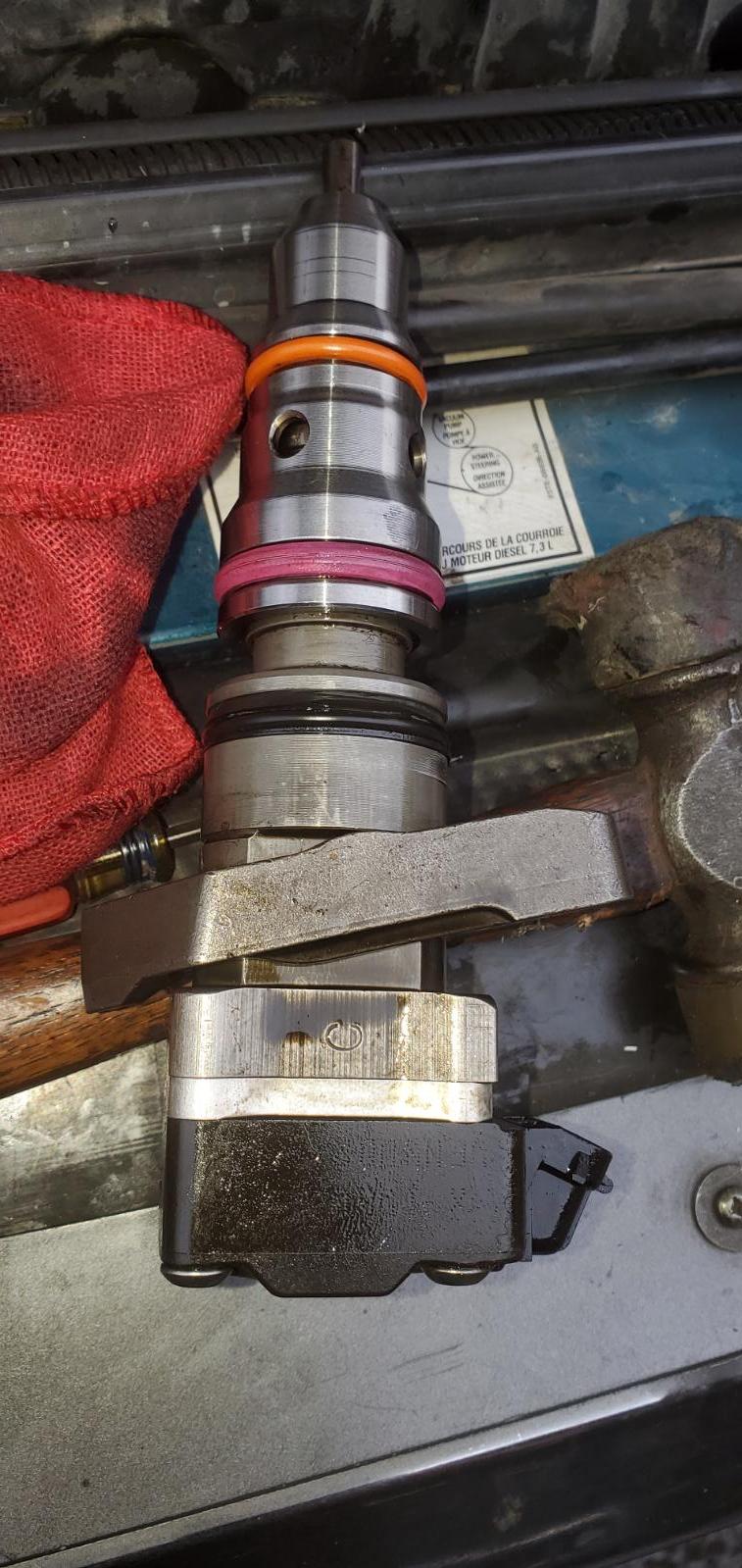
Everything posted by Mopar1973Man
-
1995 Ford F-350 Injector clean up and reseal.
Watched the same video but the HVAC case is NOT the same. There is nothing to remove and the duct is much larger and square shaped. EDIT: Yeah I see it now I went back out and spotted the screws hidden in a weird spot so not chance I'll get number 7 done... I didn't spot it because it was getting late and dark out already and couldn't see it. Now I see it in the daylight and above and below there is a small sheet metal screws.
-
Swapping a nv 4500 for a 5600
The overfill on NV5600 I feel is because PenzOil Syncromesh is too thin. Is so thin it does NOT meet the GL-4 rating and its not synthetic so failure is much more common.
-
1995 Ford F-350 Injector clean up and reseal.
I'm going to need to either take the solenoid off the top or pull the engine a long way over to the passenger just to gain another 2 inches to pull it completely out.
-
Swapping a nv 4500 for a 5600
I never over fill anymore being that causes foaming of the fluid. I use the Mobil 50 SAE trans fluid being its THICKER (90 weight gear oil) and clings to the bearing and gears better. I've never had bad shift so far after going through 2 bad sets of syncros. It is a synthetic fluid and GL-4. No issues to report. The factory 75w-85 was too expensive so after talking to my transmission builder he suggest the Mobil 50 long time ago. Abe @ Weller Truck, Boise Idaho - (208) 331-1061 https://www.google.com/search?q=weller+truck+boise
-
I feel the need to Dyno
-
1995 Ford F-350 Injector clean up and reseal.
Dang... I don't want to have to pull engine mounts to lift it on that side or take the heater case off the firewall. Some say there is no issue and some are puzzled how to remove that #7 injector. Myself I pulled it up and tried rotating all the way around and there is just no position you can gain enough room. The only thing I can think of is pull the the solenoid on top of the injector but kind of freaked that there is a spring or something in there under tension. Don't need parts flying around not knowing what's under the solenoid cover.
-
Injector Tips/ Nozzles and Wear Factors
Love too really but I'm not hooked up with any groups right now that are running any dynos that I know off. I've ran it YEARS ago and made 381/831 with Edge Comp (5x5) and stock injectors. Like I said you can be really close. Started a challenge with a friend and he was below me in power all he did was backed off the rollers into the parking lot and removed the outter duals wheel and got back up on the rollers and re-dynoed again and beat me by 5 HP. The winner was a 1997 Dodge Ram 3500...
-
Swapping a nv 4500 for a 5600
I would opt to keep the NV4500. More common and less to rebuld. Just remember I pay only $1,800 for rebuild for each of these failures. NV5600 are closer to $4,500 a rebuild. Even with me breaking all the teeth off the 5th gear and then snapping the mainshaft in half I would never upgrade to NV5600 transmission. 423k miles and still running the NV4500 but with brass syncros and Mobil 50 SAE Trans Fluid GL-4. Yeah I've even burned up 2 sets of brass syncros (defective). Still way cheaper to fix a NV4500. You have to Remember NV5600 was only made for a few years for Dodge parts are expensive and sometimes hard to get ahold of. Just remember I'm close to the 500 HP realm. DAP +150 HP injectors (7 X 0.010 @ 320 bar), Valair Organic Dual Disc, +180 HP Quadzilla Adrenaline, HX35/40 Hybrid Turbo (60/60/12). Still won't upgrade to NV5600. Turn up the Quad from Level 2 which is what I run typically (stock fuel with timing) turn it up to level 7 which is full wire tap and CANBus I can roast the tires in about any gear I wish. Hence why I tend to run level 2. https://mopar1973man.com/garage/vehicle/101-2002-dodge-ram-2500/?show=mods You'll need the bell housing, starter spacer, and a clutch being the input shaft might be different. 1st and 2nd gear are carbon fiber still, 3rd ,4th, 5th, and reverse are brass.
-
Flashing WTS light after W-T ground mod
Double check the ground wires make sure you got them all hooked up. Just make sure the ECM and VP44 are getting good ground. Flashing Wait To Start is typically a ECM error of some sort. You might grab a code reader and see what codes are displayed.
-
Injector Tips/ Nozzles and Wear Factors
Just install a Quadzilla your in the high 300's to low 400's HP just with a Quadzilla being there is about 120 to 180 HP gain. Just throw in a set of injectors you could hit 500 without much effort. I know I'm close with just the Quadzilla and +150 HP injectors to 500 HP mark. Just think stock is 235 HP SO/245 HP HO another 90 HP on stock truck would get you to that. Like I said a Quadzilla on a stock engine will surpass that in a single mod.
-
Injector Tips/ Nozzles and Wear Factors
I get it. Like Eileen's Son with his Ford only can do so much with limit incomes. Need to for sure add a fuel pressure gauge when you can so you can monitor your pressure to the Vp44.
-
Injector Tips/ Nozzles and Wear Factors
Another though. Being my AirDog 150 is a 3 line pump. This means the air that is captured is returned to the tank. But... Since there is only a small part of the fuel past along to the VP44 this means majority of this fuel is recirculated and re-filter several passes. Technically it called fuel polishing. You constant filter and refiltering the same fuel will keep fuel to the engine cleaner. Then the stock can has a filter too it will stop any particulars that slip through. Yes it does happen even with a 3um ahead of 7um filter. Full 1/2" line here from the tank to the VP44. Now my pressure is very stable with +150 HP injectors and wired tapped Quadzilla on KILL will not drop fuel pressure below my 13 PSI warning light. Very rare to see it even come on. I might drop -2 to -3 PSI from idle to 100 MPH WOT. Stock line is 6mm ID which is smaller than 1/4" fuel lines. 3/8" lines are restrictive still can flow enough so pressure drop is more pronounced on 3/8" line vs 1/2" line. So if you planning for more power you'll have to upgrade again to 1/2" lines.
-
Acceptable AC voltage with grid heaters on
Things to think about... W-T ground wire mod really does cut back the amount of AC noise fed back to the ECM and PCM which the PCM will carry that AC noise right to the field and cause it to amplify the noise. Good block and body ground are REQUIRED. If you measure above 0.2 voltage drop from battery negative post to block replace the cable(s). There is zero need to a negative cable jumper you can test by hooking up jumper cables between both negative post and measure the voltage drop with or without the jumper if there is any change change the block and body grounds. If there is no change like my truck where the voltage drop remains 3mV DC with or without a negative jump this means that it does NOTHING and has zero benefit. Actually the block can flow way more current that a jumper cable. Hence why it does nothing. Make sure your alternator is bench tested for AC ripple. Typically a full load test will create a value around 1.0 to 1.2 Volts under full load on a test stand. If the alternator is passing on the test bench it will pass on the truck as well. Grid heaters draw way more than what the alternator can charge at an idle. Don't start your truck and leave idle to warm up at 800 RPM. This is where I typically use either Mopar1973Man high idle or the Quadzilla high idle to up the RPMs to 1,200 this increase the charge rate more, increase air movement around the diodes keeping them cooler. Reduced the stress on the alternator. Bad battery cables are far more common than you think. Voltage drop test is a excellent way to verify cables and terminals for good function. Being you testing under the high loads. "Black" terminal is a lead that is oxidizing, typically a positive post. Engine oil helps reduce the amount of air contact and the acid contact on the terminals. Terminals need to have that fresh lead appearance. Lead oxide is will resist current flow, typically creates warmth to heat at that spot too. Running you hand over terminals careful and wire if you feel heat that cable is failing. Bad rotor brushes in the alternator can create AC noise as well. Some local shops could do the replacement in just like 15 minutes and retest for AC noise. (DuroBuilt, Nampa ID) - Thank @AH64ID Consider reducing total loads on the electrical system. Like I've done HID headlights which are only 35w for both. Driving lights are 18 for both. Previous light was four 100w flood lights and halogen bulbs (45w /65w). LED's are fraction of the electrical load. Look at other stuff like blower motor too if you fan only work on high the bearing are gone and the blower resistor over heated and blew out. Replace both and you'll reduce you electrical loads there. Disconnect the grid heater if you in warm climate and don't require them.
-
Injector Tips/ Nozzles and Wear Factors
Hence why I still keep the stock filter being most all replacement filters for the stock can are design to be water blocking (Fleetguard). Now the AirDog fuel filter is not water blocking (but the Fleetguard is)
-
1995 Ford F-350 Injector clean up and reseal.
I've got to admit that 7.3L engines are fairly straight forward and easy to work on. The glow plugs are under the vavle cover. As for the injectors you need a Allen wrench and remove the oil deverter. Once removed you can use a 8mm wrench on the bolt toward the intake and 8mm socket on bolt towards the exhaust. Once the two bolts are removed you can use a small pry bar to simply lift the injector out of its hole. Things to take note of Ford OEM injector seals are black and aftermarket seal are like orange a light purple color. This biggest thing is being sure your high pressure oil rail is seal and the fuel rail is sealed to prevent crossing of the two fluids or leaking out into the head area or possibly back into the fuel tank. My project truck is 1995 Ford F-350 7.3L Powerstroke. The number 7 injector I didn't find a way to remove as of yet. Number 7 is the rear most injector on the passenger side. It hits the HVAC case and will not pass... I'm hoping some here could tell me the secret on getting that bugger out. Now Jacob when he get a few extra buck for another set of seals and glow plug we'll move over to the driver side and do the other 4 injectors. We did find number 5 injector was rather carboned over. IMPORTANT! Since Ford injectors have booth the high pressure oil and the fuel rail in the head when you pull any injectors the fuel and oil drains instantly in the cylinder. So to prevent engine damage leave the glow plug out and crank it over. When you do make sure to tell everyone to back off. When I barely spun that engine over the oil shot out of #7 glow plug hole and painted the hood black in one big spurt gun. Afterwards I installed the glow plugs and went to start up mode. Being that there is no line to crack or bleed the air out you can just crank till it starts. It's no different than Cummins when it does start there is air in the fuel and oil rail so it knocks and does sound horrid. After cleaning up tools and taking off for a test run to warm it up. There was a small improvement and smoother running. Being only 3 of 8 were done we are just starting the project. Q: Does anyone know how to get #7 injectors out of the head without doing something stupid like cutting a hole in the HVAC case?
-
Acceptable AC voltage with grid heaters on
Switch out to rain for me but high country above is going to buried quickly. New Meadows, ID at Smokey Boulder McCall ID top of the Goose creek grade.
-
Injector Tips/ Nozzles and Wear Factors
If I recall the internal pressure is roughly 60 PSI heading to the distributor to be pumped up again. Also remembeer the VP44 is half the RPM at idle is only 400 RPM's on the pump.
-
Injector Tips/ Nozzles and Wear Factors
Yes. This was tested at 200:1 ratio and it still pulled 462 HFRR IIRC. Estimated 128:1 ratio is in the high 200s to low 300s HFRR for sure.
-
Sorry Everyone I haven't felt like participating much Lately.......
Ouch... Like this weekend I've been working all weekend. Like I just learned how to do 7.3L Ford injectors tonight and then got snagged on the #7 injectore rear most against the HVAC box. Never got it out. We'll revisit that injector another day. But the truck runs better with 3 cleaned up inectors and knocked off a good amount of crusty mess on number 5. We only did the passenger bank for now to resolve a weak cylinder issue. Still some miss but not nearly as bad. Soon as Jacob get some extra cash we'll do the driver side together but he get to get dirt this time. Rather nice to have a apprentice that wants to learn. I understand most of you and the long hours like myself I've been starting my morning at 4am most morning and work the website for 4 hours in the morning and then head to work. Get home in the evening and then sit down and check the website again and might work for a few hours dealing with errors or performance issues. Like this morning I was on the phone chewing out the hostring company for selling me a blacklisted IP address. So that little burp today was the IP was changed out and hopefully this IP is clean and the email problem is solved. Tomorrow I'm going back to my other shop and Jacob (Eileens Son) is going to help me do a gear case seal and help stop up some of oil leaking out of my landlords truck. Good way to pay my shop rent is by fixing the landlord truck and make it better. Always a win-win time for me. Heck Saturday in mere 2 hours I changed out his steerinfg column and even changed out his tore up steering wheel and rehooked all the stering wheel stereo controls. Carry on guys... I'll catch you in the morning I'm whipped and tired and need some sleep and get right back in the saddle and do it again.
-
Injector Tips/ Nozzles and Wear Factors
It some pretty hard steel I know that. Match the flow ot the nozzle flow rate and then the pop pressure as well. I'm sure there is much more to it but most of its how the pop pressure and lift of the pintle in general speak. As for wear I typically would say double filter your fuel. Like myself I've got a 3um filter on my AirDog 150 and then a 7um filter in the stock filter can. Lubricity of the fuel plays the other role which Bosch states <406 HFRR and the common US diesel fuel is ~520 HFRR so increased lubcitiy will improve injector performance.
-
NV4500 Clutch & Input Shaft Question
my bad i wasn't totally wake and still hammer my morning coffee.. sorry my bad...
-
Acceptable AC voltage with grid heaters on
URGENT - WINTER WEATHER MESSAGE National Weather Service Boise ID 248 AM MST Sun Nov 15 2020 IDZ011-013-016-028-033-ORZ062-151800- /O.CON.KBOI.WW.Y.0012.000000T0000Z-201115T1800Z/ West Central Mountains-Boise Mountains-Western Magic Valley- Camas Prairie-Upper Weiser River-Baker County- 248 AM MST Sun Nov 15 2020 /148 AM PST Sun Nov 15 2020/ ...WINTER WEATHER ADVISORY REMAINS IN EFFECT UNTIL 11 AM MST /10 AM PST/ THIS MORNING... * WHAT...Snow expected. Total snowfall amounts of 1 to 4 inches are forecast at elevations between 3000 and 4500 ft, with 4 to 8 inches from 4500 ft to 6000 ft, and 8 to 14 inches above 6000 ft MSL. * WHERE...Portions of eastern Oregon, west-central Idaho, and southwest-central Idaho. * WHEN...Until 11 AM MST /10 AM PST/ this morning. * IMPACTS...Travel could become very difficult. * ADDITIONAL DETAILS...Breezy conditions will result in areas of blowing snow above around 7000 ft. PRECAUTIONARY/PREPAREDNESS ACTIONS... Slow down and use caution while traveling. The latest road conditions can be obtained by calling 5 1 1.
-
Acceptable AC voltage with grid heaters on
Ouch... I've got a snow storm coming soon too.
-
Acceptable AC voltage with grid heaters on
Requirement. DVM able to measure any AC frequency below 2 volts. Black probe goes to the passenger battery. Then the red probe on the alternator charge post. Engine fully warmed up and batteriescharged up and no loads running. 0.05 AC Volts seems to be the top limit for most.
-
NV4500 Clutch & Input Shaft Question
Never upgraded input shaft. I never broke the input. Still running stock NV4500 input. I broke the main shaft and 5th gear. Hence why I went down in tires to allow it to break free and release the built up torque and spin the tires than hold tight and break stuff more. Yes. It will aid in getting it to hold. Right now your tires are holding back a lot of torque and the weakest point is the clutch so the clutch spin to release the built up torque. So what size are you running? I can calculate the ratio for you and tell you what is needed to correct. Like my old Southbend when I upgraded to +150 HP injectors and figure out the quadzilla tuning now I produce enough power on Level 2 (Stock fuel) to spin on dry pavement. Then I built more power in tuning and spun the clutch. Then upgrade to dual disc Valair. Yeah I produce a lot of power but get nearly all of it to the ground and very little loss in the driveline being my engine oil (<170*F) and trans temp are very low. (<140*F). No I didn't lose anything per se. It was a bad shaft that got a nick in the metal that is ruining my output shaft and was over looked on the build. I knew about it back when it failed the first time but with my daily task of getting @MoparMom to dialysis I just resealed the shaft and told Ryan I would deal with it later. Now later is here winter time and things are slowing down I can send it in for a replacement shaft and new seals. Again I'm using "Quick Ratio" because I'm running smaller tires. Don't install on oversized. I had a very long discussion with Ryan about this.







